AACR2 Part I - Joint Steering Committee for Development of RDA
AACR2 Part I - Joint Steering Committee for Development of RDA
AACR2 Part I - Joint Steering Committee for Development of RDA
You also want an ePaper? Increase the reach of your titles
YUMPU automatically turns print PDFs into web optimized ePapers that Google loves.
5JSC/Sec/7<br />
16 November 2008<br />
10<br />
expressions <strong>of</strong> the same work <strong>RDA</strong> specifies creating a separate access point <strong>for</strong><br />
each language expression (see <strong>RDA</strong> 6.28.3.7).<br />
• <strong>AACR2</strong> 25.16B1 says to abbreviate the name <strong>of</strong> the month used in a date in a<br />
uni<strong>for</strong>m title <strong>for</strong> a treaty. <strong>RDA</strong> Appendix B does not contain any abbreviations <strong>for</strong><br />
months.<br />
• The instructions on preferred titles <strong>for</strong> parts <strong>of</strong> the Bible at <strong>RDA</strong> 6.23.2.9 differ<br />
from <strong>AACR2</strong> 25.18A in the following ways:<br />
o The Old and New Testaments are referred to by their spelled out <strong>for</strong>ms,<br />
not the existing <strong>AACR2</strong> abbreviations “O.T.” and “N.T.”<br />
o Preferred access points <strong>for</strong> individual books <strong>of</strong> the Bible position the name<br />
<strong>of</strong> the book immediately following “Bible” rather than interposing the<br />
name <strong>of</strong> the appropriate Testament.<br />
o Preferred access points in the <strong>for</strong>m “Bible. Old Testament”, “Bible. New<br />
Testament”, and “Bible. Apocrypha” are used to identify those groupings<br />
<strong>of</strong> the Bible as aggregate works.<br />
(See the 5JSC/LC/8 series <strong>for</strong> background in<strong>for</strong>mation.)<br />
• According to <strong>AACR2</strong> 25.18A11, when a version <strong>of</strong> the Bible is identified by the<br />
name <strong>of</strong> the translator, and there are more than two, the name <strong>of</strong> the first is<br />
followed by “et al.”. According to <strong>RDA</strong> 6.25.1.4, “and others” will be used<br />
instead.<br />
• The abbreviation “Ms” is used in <strong>AACR2</strong> <strong>for</strong> “Manuscript” (<strong>AACR2</strong> 25.22B). In<br />
<strong>RDA</strong> (6.30.4) the abbreviation is not used.<br />
• Some additions to uni<strong>for</strong>m titles <strong>for</strong> music will no longer be abbreviated:<br />
“arranged” (<strong>AACR2</strong> 25.35C1); “accompaniment” and “unaccompanied” (<strong>AACR2</strong><br />
25.30B10).<br />
Chapter 26 - References<br />
• The instruction at <strong>AACR2</strong> 26.1H has been omitted from <strong>RDA</strong> because it is too<br />
prescriptive: “Do not make a reference if the reference is so similar to a heading<br />
(name and/or title) or to another reference as to be unnecessary.”<br />
• <strong>AACR2</strong> 26.3C1 b) covers explanatory references applicable to several headings.<br />
These types <strong>of</strong> references do not have a place in the <strong>RDA</strong> schema as there is no<br />
relationship that is being recorded.




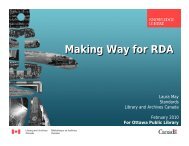
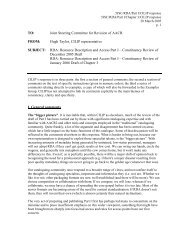
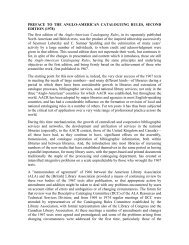
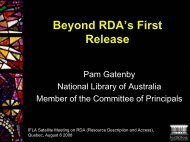



![Presentation slides [PDF] - Joint Steering Committee for ...](https://img.yumpu.com/41621230/1/190x143/presentation-slides-pdf-joint-steering-committee-for-.jpg?quality=85)

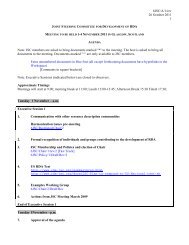
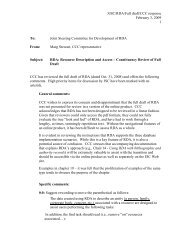
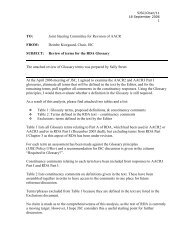
![Presentation slides [PDF] - Joint Steering Committee for ...](https://img.yumpu.com/35256207/1/190x143/presentation-slides-pdf-joint-steering-committee-for-.jpg?quality=85)
